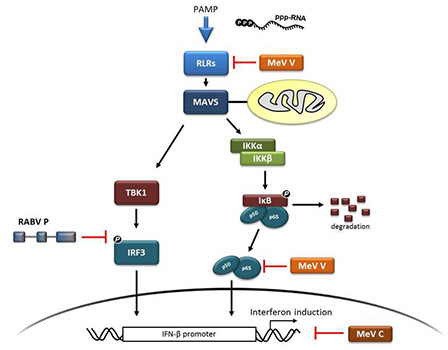Conzelmann Lab - Research
- Research
- Trans-synaptic Tracing
- Innate Immune Response
Innate Immune Response to RNA Viruses
Co-evolution of viruses with their hosts has led to a highly complex and powerful immune system for discrimination of self- and non-self, or harmless and dangerous on the one hand, and elaborate mechanisms regulating recognition and immune responses, on the other. RNA viruses are sensed predominantly by RNA pattern recognition receptors like RIG-I and TLRs. We are studying the exact nature of the RNA PAMPs of rhabdo- and paramyxoviruses (Runge et al., 2014), how their recognition is prevented, e.g. by shielding the viral RNA in an RNP complex, and how the immune response is downregulated by viral proteins. Particularly early cytokines such as type I and III interferons (IFNs), which integrate innate and adaptive immune responses, are essential targets for viruses.

Interference with interferon induction by RABV (left) and measles virus proteins (right)
Viruses are facing pretty different challenges, depending on their tropism. Two models are currently under investigation, namely the neurotropic rabies virus, and measles virus, which replicates in blood cells, which are sentinels for PAMPs and have specialized pathways to mount a vigorous immune response. Accordingly, measles virus is armed with several “immune escape” proteins (P, V, C) able to interfere with multiple pathways leading to interferon and inflammatory cytokine expression. This includes for example the pDC specific TLR9/MyD88- pathway, and NF-kB signaling, which are targeted by the V protein, as we could show recently (Sparrer et al., 2012). RNAseq and bioinformatics is being used to decipher the multiple effects of measles virus infection and single protein expression on the host transcriptome. Rabies virus in contrast relies on a single P protein specialized in preventing interferon induction by IRF3 and JAK/STAT-mediated ISG expression, but not NF-kB induction (reviewed by Rieder and Conzelmann, 2011). Current studies are deciphering the molecular mechanisms behind this very potent immune suppression. Studying the molecular mechanisms behind, we can learn from viruses how the immune system can be activated (by virus-like RNA PAMPs) and how it can be suppressed (by viral antagonist-like factors).
People involved: M.Sc. Alexandru Hennrich, Dr. Alexander Ghanem

